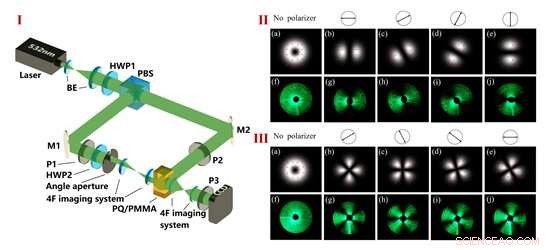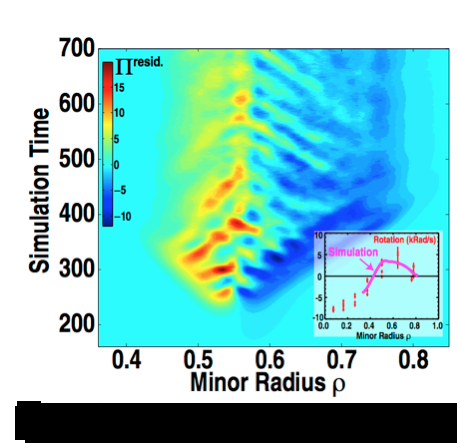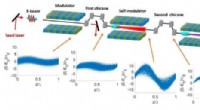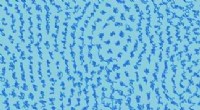Lineær polarisationsholografi

Figur Ⅰ, en dynamisk eksponeringsenhed, der genererer vektorstråler ved hjælp af ortogonal interferens til optagelse og rekonstruktion; Ⅱ, (a)-(e) er simuleringerne af lysfeltfordelingen af førsteordens vektorstråle efter tilføjelse af polarisatorer, (f)-(j) er førsteordens vektorstråle modtaget af CCD i eksperimentet; Ⅲ, (a)-(e) er simuleringerne af lysfeltfordelingen af andenordens vektorstråle efter tilføjelse af polarisatorer, (f)-(j) er andenordens vektorstråle modtaget af CCD i eksperimentet. Kredit:Compuscript Ltd
I konventionel holografi dannes hologrammet ved at optage interferenskanterne af to kohærente stråler under anvendelse af et lysfølsomt materiale. Amplitude- og faseinformationen af den oprindelige signalbølge kan rekonstrueres korrekt, når hologrammet læses. Ved at introducere lysets polarisationskarakteristika i konventionel holografi kan der tilvejebringes flere frihedsgrader til styring af optisk information. Men i rekonstruktionen af polarisationsholografi, selvom amplituden og fasen af signalbølgen kan rekonstrueres korrekt, viser polarisationsinformationen rige ændringer. Denne ændring er ikke kun relateret til polarisationstilstande og interferensvinkler af forskellige typer stråler i optagelses- og rekonstruktionsstadierne, men også til egenskaber såsom polarisationsrespons, diffraktionseffektivitet af fotoreceptormaterialerne.
Polariseret holografi er stadig på vej frem. Diffraktionseffektiviteten og polarisationstilstanden af rekonstrueret bølge undersøges hovedsageligt under holografisk optagelse og rekonstruktion. I de senere år har polarisationsholografi fået stor opmærksomhed med introduktionen af tensorteori. Ved at introducere den teoretiske model af den dielektriske tensor gør denne teori polarisationsholografien anvendelig til enhver interferensvinkel og polarisationstilstand, hvilket giver en enklere og bredt anvendelig teoretisk støtte til beregning af polarisationstilstanden af den rekonstruerede bølge. Med den kontinuerlige uddybning af teoretisk forskning om polarisationsholografi er det begyndt at komme ind på forskellige anvendelsesområder. Det har brede udviklingsmuligheder inden for holografisk datalagring, lys-materiale-interaktion, mikro-nano-strukturbehandling og -fremstilling, specielle optiske enheder og så videre.
Forskerholdet af prof. Xiaodi Tan fra Fujian Normal University er et af de tidligste hold til at udføre forskning i polarisationsholografi i verden. De har gjort en række fremskridt inden for polarisationsholografi. Baseret på vektoregenskaberne for polariserede bølger foreslog de begreberne trofast rekonstruktionseffekt (FRE), ortogonal rekonstruktionseffekt (ORE) og nulrekonstruktionseffekt (NRE) og analyserede dannelsesbetingelserne og den interne mekanisme.
Gennemgangsartiklen publiceret i Opto-Electronic Science , titled "Linear polarization holography," reviews and summarizes the development of a basic component of polarization holography (linear polarization holography) based on the achievements of research teams across the world in recent years. In the linear polarization holography, the law of the change of the polarization state and the diffraction efficiency of the reconstructed wave are mainly studied, including FRE, ORE and NRE. The article distinguishes whether the polarization characteristics of the reconstructed wave is affected by the exposure energy, and then divides it into two categories for discussion. In the reconstruction characteristics that independent of the exposure energy, the polarization characteristics of the reconstructed wave change linearly with the exposure energy, which is realized by constraining the polarization state in the process of holographic recording and reconstruction.
Combined with these reconstruction characteristics, applications such as multi-channel polarization multiplexing or vector beams generation can be realized. The experimental results verify that polarization holography can improve information storage capacity, or generate vector beams with polarization and phase vortices. Generally, the polarization characteristics of the reconstructed wave is affected by the exposure energy and present a nonlinear change. These characteristics can provide references for analyzing the polarization and diffraction efficiency characteristics of holographic gratings with micro-nano structures. In addition, it is expected to make metamaterial with anisotropic refractive index distribution through multiple exposure, to realizing the modulation of the amplitude, phase, polarization and propagation direction of light, which can allow potential applications such as optical metasurfaces, photonic crystal, all-optical logic gate, polarization sensor and so on. Consequently, it is conducive to the production of linear and nonlinear optical functional devices with low-cost planar structures, and planar optical elements with a customer-design function are possible owing to its properties. This paper aims to provide new insights and ideas, so that polarization holography can be helpful in more areas as well as be widely used. + Udforsk yderligere
Metasurfaces control polarized light at will
 Varme artikler
Varme artikler
-
 Vender til fysikkens love for at studere, hvordan celler bevæger sigKredit:Pixabay/CC0 Public Domain Forskere har længe været optaget af at forsøge at forstå, hvordan celler bevæger sig, for eksempel i jagten på nye måder at kontrollere spredningen af kræft på. B
Vender til fysikkens love for at studere, hvordan celler bevæger sigKredit:Pixabay/CC0 Public Domain Forskere har længe været optaget af at forsøge at forstå, hvordan celler bevæger sig, for eksempel i jagten på nye måder at kontrollere spredningen af kræft på. B -
 Simuleringer af DIII-D eksperimenter kaster lys over mystiske plasmastrømmeSimulering af plasmaturbulens, der genererer positiv (rød) og negativ (blå) restspænding, der driver rotationsforskydning. (indsat) Sammenligning mellem målt og simuleret rotationsprofil. Kredit:W. X.
Simuleringer af DIII-D eksperimenter kaster lys over mystiske plasmastrømmeSimulering af plasmaturbulens, der genererer positiv (rød) og negativ (blå) restspænding, der driver rotationsforskydning. (indsat) Sammenligning mellem målt og simuleret rotationsprofil. Kredit:W. X. -
 Forskere foreslår en ny selvmoduleringsordning i seedede frielektronlasereSelvmoduleringsskemaet sammen med elektronstrålens langsgående faserum i forskellige positioner. Kredit:SARI Frøelektronlasere (FELer), som bruger frekvensop-konvertering af en ekstern seed-laser
Forskere foreslår en ny selvmoduleringsordning i seedede frielektronlasereSelvmoduleringsskemaet sammen med elektronstrålens langsgående faserum i forskellige positioner. Kredit:SARI Frøelektronlasere (FELer), som bruger frekvensop-konvertering af en ekstern seed-laser -
 Fysikere beviser, at 2-D og 3-D væsker er fundamentalt forskelligeDette er et billede af atomare baner i en todimensionel væske, genereret af computersimuleringer. De fleste baner er aflange, og forlængelsen af tætte baner er ens. Dette er den visuelle signatur af
Fysikere beviser, at 2-D og 3-D væsker er fundamentalt forskelligeDette er et billede af atomare baner i en todimensionel væske, genereret af computersimuleringer. De fleste baner er aflange, og forlængelsen af tætte baner er ens. Dette er den visuelle signatur af
- Sådan beregnes metan nummer
- Hvis noget fizzes betyder det, at det giver af en gas?
- ANA reducerer profitprognosen med 71% på grund af pandemi
- Estimering af isens slid på fysiske strukturer i de kommende årtier eller endda århundreder
- Happy hour for tidsopløst krystallografi
- Bransons Virgin Galactic for at blive offentliggjort:rapport


